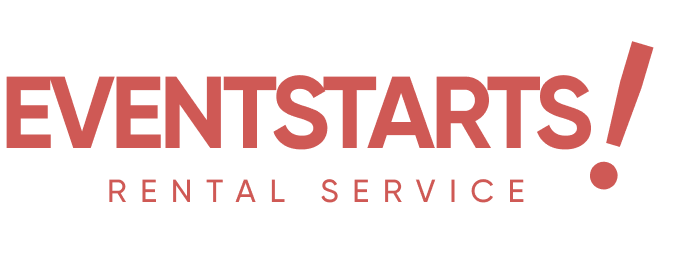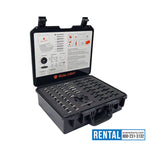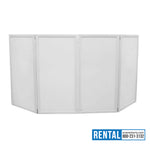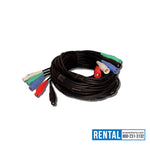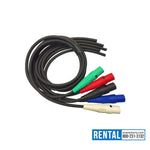You have no items in your shopping cart.
Truss Systems Explained: The Backbone of Stage Design
In the world of event staging, lighting setup, and sound system installation, one often-overlooked yet absolutely critical component is the truss system. Whether you're attending a large-scale music festival, a corporate conference, or a theatrical performance, chances are that you're surrounded by an intricate network of aluminum beams supporting lights, screens, speakers, and even stage decor. These beams are known as trusses - the unsung heroes of stage engineering.
In this comprehensive guide, we will break down what truss systems are, the different types available, and how they are used in modern event production. Whether you're an event organizer, production company, or AV technician, understanding trusses is key to building safe and visually impressive stages.
What Is a Truss System?
A truss system is a framework of interconnected metal beams, typically made of lightweight aluminum or steel, used to support lighting, audio, and video equipment during live events. The design of trusses ensures strength, rigidity, and load distribution, allowing them to carry heavy gear while maintaining structural integrity.
The core benefit of trussing is the ability to create elevated, customizable, and safe structures that can adapt to various stage sizes and layouts. From intimate indoor setups to massive outdoor festivals, trusses serve as the foundation for everything mounted above ground.
Why Trusses Matter in Stage Design
Trusses play a vital role not just structurally, but also aesthetically. Their modular design offers flexibility for creative stage architects, who often use truss layouts to shape the visual identity of an event.
Truss systems make it easy to:
-
Suspend lighting equipment for optimal illumination and dynamic effects
-
Mount LED walls and projection screens for immersive visuals
-
Position line array speaker systems for even sound distribution
-
Install special effects devices like fog machines or lasers
-
Create entrance arches, roof structures, and custom stage frames
They also simplify transport and assembly. Most trusses are designed to be lightweight and modular, which allows crews to easily set them up and dismantle them quickly, saving time and labor costs.
The Main Types of Trusses
When choosing the right truss for your event, it’s important to understand the different configurations available. Each type serves a unique purpose and is chosen based on factors such as load capacity, design preference, and venue constraints.
1. Box Truss (Square Truss)
Box truss is the most robust and commonly used type of truss. It features four main chords (tubes) arranged in a square layout, with internal diagonal bracing for added strength.
Advantages:
-
High load-bearing capacity
-
Suitable for long spans
-
Extremely stable for heavy lighting and sound rigs
-
Versatile for both horizontal and vertical builds
Typical use cases: Large concerts, festival stages, outdoor structures, flown video walls.
2. Triangle Truss
As the name suggests, this type has three main chords, forming a triangular cross-section. It is lighter than box truss but still offers good load distribution.
Advantages:
-
Lightweight and cost-effective
-
Easier to transport and handle
-
Ideal for moderate weight loads
Typical use cases: Mobile stages, trade shows, smaller lighting rigs, decorative arches.
3. Ladder Truss
Ladder truss, sometimes called flat truss, consists of two main tubes connected by horizontal or diagonal rungs. It is primarily used in applications that require minimal load-bearing and maximum portability.
Advantages:
-
Extremely lightweight
-
Simple to install
-
Great for low-profile or decorative use
Typical use cases: Exhibition booths, light banner supports, ceiling decor, temporary signage.
Materials Used in Truss Systems
The two main materials used in truss manufacturing are:
-
Aluminum: Lightweight, corrosion-resistant, and easy to handle. Ideal for touring setups and mobile events.
-
Steel: Heavier but much stronger, used for permanent installations or situations where heavy-duty support is needed.
Aluminum is the preferred choice for most modern truss systems due to its strength-to-weight ratio and resistance to weathering.
Modular Design and Connection Types
Trusses are built to be modular, which means they can be easily expanded or reconfigured for different event needs. Standard lengths range from 0.5 to 4 meters, and truss segments are connected using various systems, including:
-
Spigot connections (quick and tool-free)
-
Bolt connections (more secure and stable)
-
Conical couplers (used for precision and load distribution)
This modularity makes it possible to customize stage setups based on venue dimensions, ceiling heights, and technical requirements.
How Truss Systems Support Audio and Lighting Setups
Proper truss planning is essential for the success of audio-visual installations. Here’s how trusses integrate with core components:
Lighting
-
Trusses provide elevation to lighting fixtures, allowing designers to create beams, washes, strobes, and other effects.
-
They offer flexibility for rigging different types of moving heads, spotlights, PAR cans, and LED bars.
-
Trusses can be mounted on ceilings, flown above the audience, or placed as vertical towers.
Audio
-
Trusses are often used to suspend line array speaker systems for balanced sound coverage across large areas.
-
Flying subwoofers and side-fills improves acoustic performance and saves stage space.
-
They enable directional control, minimizing sound bleed into unintended zones.
Video
-
Trusses support LED walls, projection surfaces, and digital signage.
-
Their weight capacity and customizable shape make them ideal for framing high-resolution screens used in concerts and presentations.
Truss Safety and Load Ratings
Safety is paramount when dealing with suspended equipment. Each truss component comes with a certified load rating, which indicates the maximum weight it can safely support.
Considerations include:
-
Point load vs. distributed load: Concentrated weight can stress a single area, while even distribution enhances safety.
-
Rigging hardware: Shackles, clamps, and safety cables must match or exceed the truss's load capacity.
-
Wind loads: Outdoor events must factor in potential wind speeds, especially for rooftop truss structures.
Always consult with a certified rigger or structural engineer during planning to ensure compliance with local safety regulations.
Custom Truss Structures
For events that demand uniqueness, trusses can be custom-built into creative forms like:
-
Circular trusses for center-stage lighting
-
Curved trusses for immersive audience enclosures
-
Multi-level grids for theatrical sets or fashion runways
-
Interactive structures with integrated LED lighting
Creative use of trussing transforms the stage from a functional platform into a visual spectacle.
Indoor vs. Outdoor Applications
Different environments call for different truss setups:
Indoor:
-
Ceiling-mounted grid systems for concerts and theater
-
Temporary lighting trusses for corporate events
-
Minimalist ladder trusses for exhibition booths
Outdoor:
-
Large box truss arches for festival stages
-
Weather-resistant aluminum trusses with rain protection
-
Wind-braced support systems for stability
Planning for outdoor use requires special attention to durability, weatherproofing, and anchoring methods.
Conclusion
Truss systems are the invisible framework that makes modern events possible. From small indoor setups to grand festival stages, they provide the foundation for every visual and audio experience. Understanding the types of trusses — box, triangle, and ladder — and how they serve specific roles in structural design empowers event professionals to build safer, more impactful productions.
Whether you're planning your next concert, corporate event, or trade show, don’t underestimate the power of the truss. It’s not just about holding equipment — it’s about elevating your entire production.
If you're looking for high-quality truss rental, stage design, or complete event production solutions, visit EventStarts.com - your trusted partner in creating unforgettable live experiences.
